#akwamu
Explore tagged Tumblr posts
Text
On November 23, 1733, 150 African slaves from Akwamu, in present-day Ghana, revolted against the owners and managers of the island's plantations. Led by Breffu, an enslaved woman from Ghana, and lasting several months into August 1734, the slave rebellion was one of the earliest and longest slave revolts in the Americas. The Akwamu slaves captured the fort in Coral Bay and controlled most of the island.
Today, the 40th annual pilgrimage and commemoration of the 1733 revolution was held. Libations and celebrations to our ancestors. Forgot to add the flag…St. John USVI 🇻🇮🇻🇮🇻🇮
7 notes
·
View notes
Text
Mythic Creatures by Region & Culture
Part 9: Africa
Here is the overview of global creatures.
Cross-Cultural (across multiple but not all cultures)
Amadlozi of the Nguni people in South Africa; Anansi is Akan (which includes the Agona, Akuapem, Akwamu, Akyem, Anyi, Ashanti (!!!!!!!), Baoulé, Bono, Chakosi, Fante, Kwahu, Sefwi, Wassa, Ahanta, and Nzema) also found in African American lore; Asanbosam is Akan (which includes the Agona, Akuapem, Akwamu, Akyem, Anyi, Ashanti (!!!!!!!), Baoulé, Bono, Chakosi, Fante, Kwahu, Sefwi, Wassa, Ahanta, and Nzema) also found in Jamaican slave lore; Death; Jengu various peoples in Cameroon; Madam Koi Koi; Mami Wata; Mazomba; Mbombo; Mbuti Mythic Creatures; Mbwiri; Nandi Bear; Ninki Nanka; Nyami Nyami; Obambou; Obia also name for a creature in Latin American folklore (Garifuna of Bay Islands, Honduras); Ogun; Oshun; Shetani; Somali myth; Werehyena; Yumboes Wolof; Zār; Zuhri
allegedly African
Aegipan; Amphisbaena, in Greek myth, Perseus flies over Libya with head of Medusa…blood creates Amphisbaene; Catoblepas; Cerastes; Crocotta; Dingonek East Africa 1907-1918; Ethiopian pegasus; Forest Bull; Gold-digging ant; Griffon; Hypnalis; Leontophone; Lycaon; Macrobian; Pard; Pygmies; Rompo; Scitalis; Seps; Struthopodes maybe??; Syrbotae; Tarand; Theow; Wild Man, Wild Woman ; Wild Men, Wild Women; Yale
Angola
Kishi
Ashanti
Anansi; Asanbosam; Obayifo
Benin
Aido Hwedo, also in Haiti
Canary Islands (Guanches)
Guayota; Maxios; Tibicena; Witches of Anaga
Congo
Abada; Bunzi; Eloko ; Biloko; Jengu also known in Cameroon, called Bisimi with the Bakongo; Mfinda; Nkisi; Nkondi; Simbi
Dahomey
Aziza
Dogon
Nommo
Ethiopia
in the Quran, an Aksumite (Ethiopian) siege is averted by birds dropping stones: Ababil; Buda (Ethiopia & Eritrea, were-hyena & evil eye); Ethiopian superstition; Holawaka (Oromo, Ethiopia);
Igbo
Ibo loa also Haiti
Nkomi & Bakalai, Gabon
Koolakamba
Ghana
Abonsam, also Gold Coast; Adze, possessing "vampire" who stalks prey as firefly among the Ewe of Togo and Ghana
Gold Coast
Abonsam, also in Ghana
Kalenjin, Kenya
Kalenjin Mythic Creatures
Khoikhoi
Aigamuxa
Lingala
Mokele-mbembe
Lugbara (Congo to Sudan)
Adroanzi, "angels", benevolent children of the god Androa, but if you turn around to look at them you die
Malagasy
Kalanoro; Vazimba; Yateveo (Plant) alleged
Mozambique
Agogwe sighted by 2 Europeans in 1926-1927 but existed prior as a word & creature in indigenous oral traditions
Songhay
Hira; Zin Kibaru
Sotho, South Africa
Kammapa; Monyohe
South African Folktales Grootslang
Tswana
Matsieng
Uganda
Jok (among Acholi of Uganda and South Sudan); Lukwata (Baganda of Uganda);
West Africa
Adze, possessing "vampire" who stalks prey as firefly among the Ewe of Togo and Ghana; Ekpo Nka-Owo (Ibibio, Southern Nigeria); Wereleopard; Zin;
Xhosa
Amafufunyana (possession, schizophrenia); Uhlakanyana
Yoruba
Abiku; Egbere; Emere; Shango; Yemọja
Zambia
Ilomba among the Lozi people
Zanzibar
Popobawa
Zimbabwe
Zimbabwe Bird
Zulu
Inkanyamba; Isitwalangcengce; Lightning Bird; Tikoloshe; Uhlakanyana; Umamba; Usiququmadevu; Zulu religion
Ancient Egypt
Aani; Abezethibou, Testament of Solomon, acted during Book of Moses in Egypt; Abtu; Abyzou; Akhekh; Ammit; Anubis; Apophis; Ba (personality); Bennu; Griffon; Hieracosphinx; Isfet; Medjed; Mehen_Board_Game_Snake_God_Egypt; Meretseger; Nemty; Serpopard; Set animal; Sphinx; Taweret; Teka-her; Unut_Egypt_Rabbit-Snake-Lion_Goddess; Uraeus; Wadjet
allegedly Ancient Egyptian
Cynocephali; Phoenix
Notify me if there are mistakes or if any of these creatures, beings or figures should not be used in art or fiction. (Note that every artist & writer should consider whether use of these figures is appropriate whether someone has complained or not).
#mythic creatures#mythic creature list#legendary creatures#legendary creature#legendary being#legendary beings#creature list#legendary creature list#monster list#list of monsters
9 notes
·
View notes
Text

King Osei Kofi Tutu (1660-117) the fourth ruler of the Ashanti Empire, serving (1701-17) was one of the most important leaders of the state that is now part of modern-day Ghana. He was part of the royal court of Denkyira and Akwamu. Having learned about politics from Akwamu, and with their military and political support, he took the throne of the Ashanti Empire in 1701. The Ashanti conquered Denkyira’s dependencies and other neighboring states, making it the most powerful state in the region. Okomfo Anokye, his principal lieutenant, assisted him in establishing a capital at Kumasi and giving the Empire a constitution, a standing army, and a long era of political stability. He established the Golden Stool as the symbol of the Empire.
Before he became ruler, the Akan-speaking people were moving toward creating a centralized state. Nearly all the chiefs of the Amantoo belonged to the same clan, so the idea of a union of peoples was already instilled. He took advantage of this sense of union and convinced the various chiefs that the Golden Stool was the soul, power, and energy of the Ashanti people. He was able to infuse a sense of nationality within the Empire and thus more easily incorporated the various Akan-speaking groups. The Golden Stool remains the symbol of Ashanti unity today.
The various chiefs ruled their local areas under power derived from the Asantehene. Each year a festival was held in Kumasi attended by all of the chiefs who swore their loyalty to the Asantehene.
Territorial expansion was rapid for the Ashanti Empire. The highly organized Ashanti Army included cavalry, infantry, scouts, royal bodyguards, and other units with the Asantehene as the supreme military commander. This military organization was far more advanced than most of Ashanti’s neighbors.
He died while waging war against a neighboring people, the Akyem. The Empire he created would continue until defeated by the British in 1900 and incorporated into the Gold Coast Colony. #africanhistory365 #africanexcellence
0 notes
Text
BREFFU // LEADER OF THE 1733 SLAVE INSURRECTION
“She was an Akwamu leader of the 1733 slave insurrection on St. John (then known as St. Jan) in Danish West Indies. She killed herself with 23 other rebels to evade capture as the rebellion weakened in 1734.”

0 notes
Text
Akwamu residents issue two-week ultimatum to govt over lack of projects
Residents of Akwamu in the Asuogyaman District of the Eastern Region have given the government a two-week ultimatum to address several pressing issues affecting their community. Over the weekend, the residents staged a protest to voice their frustration over what they see as neglect by successive governments. Also Read: Residents force motorbike thief to swim in choked gutter Dressed in red…
0 notes
Text
Video - Akwamumanhene destools subchief for unlawful land sale
Ghana News Today – home for all trending entertainment news & insights. We break all latest news and entertainment trends as it happens. check out the new exclusive below. Odeneho Kwafo Akoto III, the Akwamumanhene, has ordered the immediate destoolment of Nana Ofei Owobie, Odikro of Akwamu Anyansu, for various violations including land sales and disregarding traditions. Despite several notices,…

View On WordPress
0 notes
Text

𝗕𝗥𝗘𝗙𝗙𝗨 (?-1734)
Breffu, an African woman from what is now the nation of Ghana, who was enslaved in the Danish West Indies, is credited with leading one of the longest recorded slave revolts in North American history.
Denmark began its involvement in the African slave trade in 1657. Fifteen years later in 1672, after defeating the local Taino Indians, they began colonizing three West Indies Islands, naming them St. Jan (now St. John), St. Thomas, and St. Croix, the Danish West Indies (now the U.S. Virgin Islands.) These islands soon became the center for three cash crops: sugar cane, cotton, and coffee. Plantations were established, sugar mills were built, and enslaved people were brought from West Africa to provide the labor for these enterprises.
By the beginning of the eighteenth century, the Danish West India and Guinea Company focused its slave trading operations in and around the city of Accra in what is now Ghana. The Akwamu people of the Akan region had defeated the Accra and enslaved the conquered tribal members before selling them to the Dutch. Eventually the Akwamu were defeated Akyem people after the death of their ruler, King Ansa Sasraku and by 1730, many Akwamu people, now enslaved, were sold to Danish slave traders and transported to the island of St. John, in the Danish West Indies.
Late in 1733, in retaliation for rough treatment and harsh living conditions, enslaved people across the island of St. John, including many newly arrived Akwamu, fled their plantations and hid in the woods where they planned a revolt. They were organized by members of the Akwamu royal family who had also been enslaved and were residing on different plantations. The leaders included Prince June, Prince Kanta, King Bolombo, Prince Aquashie, and Princess Breffu who was enslaved on the plantation of Pieter Kroyer in Coral Bay, St. John.
Early on November 23, 1733, slave insurrections begun on St. John island. A local magistrate, Johannes Sodtmann was killed at his Coral Bay plantation. Soon afterwards enslaved people were admitted into Fort Fredericksvaern to make their regular delivery of wood, and once inside, they killed the guards with knives previously hidden inside of delivered wood. At the sound of the cannon being fired at the fort, the pre-set signal, Breffu burst into the main house of the Kroyer plantation and killed both Kroyer and his wife. Breffu and her followers took all the guns and ammunition on the Kroyer plantation and then attacked the neighboring Van Stell plantation where they killed three members of that family.
With Breffu as their leader, the Akwamu people took control of most of St. John Island, destroying homes and burning crops. The insurrection lasted until early in April 1734 when the French military agreed to help the Danes regain control of the island. In late April, Breffu and twenty-three of her followers committed suicide in a ritual ceremony on Brown’s Bay to avoid capture. By May, French soldiers had crushed the rebellion and Dutch plantation owners returned to their properties. The last Akwamu rebels were killed by August the same year, ending the nine-month slave rebellion. Breffu is remembered as the “Queen of St. John” and is celebrated annually with a parade and re-enactment of the insurrection.
#breffu#ghan#ghana#african#afrakan#kemetic dreams#brownskin#afrakans#brown skin#african culture#africans#akwamu#slave rebellion
129 notes
·
View notes
Video
After tracing his ancestry, actor Michael Jai White is crowned a king of Akwamu in Ghana. he is now a Ohene (King) with the title of Nana Akoto lll, Odopon “The Tree With Strong Roots That Does Not Fear The Storm”. ✊🏾✊🏾✊🏾 . . . #SIRenity #SIRenityToday #michaeljaiwhite #Ohene #akwamu #ancestry #blackwealth #blacknews #blackexcellence #blackquotes #blackhealth #blackboyjoy #blackboymagic #blacklove #blackdads #blackfathers #blackhusbands #brotherhood #blackbusiness #blackpower #discussions #BlackMen #mentalhealth #blacknews #blackmentherapist #positiveblacknews #therapy #blackmenmentalhealth #blacktherapist #positivenews https://www.instagram.com/p/BsVy76bBU2h/?utm_source=ig_tumblr_share&igshid=1040crcws5ygz
#sirenity#sirenitytoday#michaeljaiwhite#ohene#akwamu#ancestry#blackwealth#blacknews#blackexcellence#blackquotes#blackhealth#blackboyjoy#blackboymagic#blacklove#blackdads#blackfathers#blackhusbands#brotherhood#blackbusiness#blackpower#discussions#blackmen#mentalhealth#blackmentherapist#positiveblacknews#therapy#blackmenmentalhealth#blacktherapist#positivenews
2 notes
·
View notes
Photo
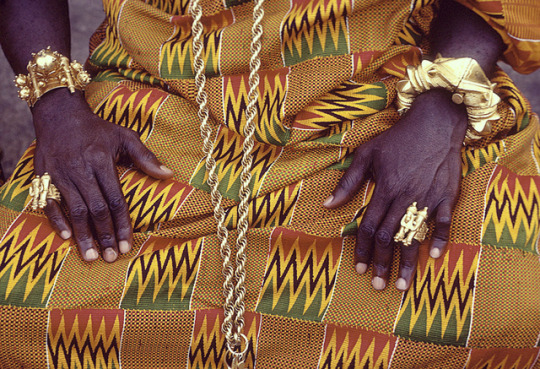
Gold in Ghana - Asante Paramount Chief
394 notes
·
View notes
Photo

I just got to #Atimpoku in the #Asuogyaman district for the maiden edition of the ADOMI INTERNATIONAL RIVER FESTIVAL organized by @AppriseMusik & The Asuogyaman District Assembly. The 4days event started yesterday,7th August,2019 with Durbar of chiefs couple with heavy Cultural performances. This is the line up for today. - Exhibition, Music, Food, Comedy and Lake ride experience. Tomorrow (Friday) Candle light procession & fireworks. Re-enactment of the Asamani story Saturday - Street carnival & Water sports competition. So now you know where to spend your weekend with Bae and the entire family. We have countless number of Hotels around including, @TheRoyalSenchi for your weekend stay. #AdomiBridge #AtimpokuBridge #YearofReturn @MTNGhana #Jonilar #TourismBlogger #TravelBlogger #GhanaBlogger #AfricanBlogger #JonatTours #Akwamu (at Atimpoku) https://www.instagram.com/p/B051tLkhZbD/?igshid=j8jau88ny3av
#atimpoku#asuogyaman#adomibridge#atimpokubridge#yearofreturn#jonilar#tourismblogger#travelblogger#ghanablogger#africanblogger#jonattours#akwamu
0 notes
Text
Mythic Creatures by Culture & Region
Part 2: Settler (Colonial) & Diasporic Tales of Australia & the Americas
Overview here.
• Australian Settler Folktales Drop Bear; Easter Bilby; Oozlum Bird (oozlum bird also in Britain)
Canadian Settler Folktales
Cadborosaurus B.C.; Cressie; Igopogo Barrie; Manipogo; Memphre; Mussie; Red Lady; Thetis Lake Monster; Turtle Lake Monster
USAmerican Settler folktales including African diaspora
Agropelter, Maine & Ohio; Alfred Bulltop Stormalong Massachussets; Altamaha-ha in Georgia, U.S.A, see Muskogee; Anansi is Akan (which includes the Agona, Akuapem, Akwamu, Akyem, Anyi, Ashanti, Baoulé, Bono, Chakosi, Fante, Kwahu, Sefwi, Wassa, Ahanta, and Nzema) also found in African American lore; Red Ghost (Arizona camel with skeleton on its back); Augerino western USA, including Colorado; Axehandle hound Minnesota and Wisconsin; Ball-tailed cat; Beaman Monster; Bear Lake Monster; Beast of Bladenboro; Beast of Busco; Bell Witch; Belled buzzard American South; Bessie northeast Ohio and Michigan; Bigfoot; Black Dog; Blafard; Bloody Bones; Bloody Mary; Boo hag; Br'er Rabbit; Brown Mountain Lights; Cactus cat American Southwest; Calafia Amazon Queen (Caliph) that California is named after; Champ; Chessie; Dark Watchers; Demon Cat Washington D.C.; Dewey Lake Monster; Dover Demon; Dungavenhooter Maine, Michigan; Emperor Norton; Enfield Monster (NOT Enfield); Flathead Lake Monster; Flatwoods Monster; Flying Africans; Fouke Monster Arkansas; Fur-bearing trout; Gallinipper; Gillygaloo; Glawackus; Gloucester sea serpent; Golden Bear; Goofus Bird; Gumberoo; Hidebehind; Hillbilly Beast of Kentucky; Hodag; Honey Island Swamp Monster; Hoop Snake; Hudson River Monster; Hugag; Jackalope; Jersey Devil; Joint Snake; Jonathan Moulton; Lady Featherflight; Lagahoo; Lake Worth Monster; Lava bear Oregon, appear to have been real animals but not a unique species; Letiche (Cajun folktale, from descendants of the Acadian expulsion) Lizard Man of Scape Ore Swamp; Loveland Frog; Ludwig the Bloodsucker; Mãe-do-Ouro; Mami Wata also African; Maryland Goatman; Melon-heads; Michigan Dogman; Milton lizard; Mogollon Monster; Momo the Monster; Mothman; Nain Rouge Detroit, Michigan; New Jersey folktales; North Shore Monster; Onza; Ozark Howler; Pope Lick Monster; Proctor Valley Monster; Railroad Bill; Red Ghost; Red Lady; Reptilian; Resurrection Mary; Sharlie; Sidehill Gouger; Signifying monkey; Skunk Ape; Snallygaster; Snipe Hunt; Snow Snake; Splintercat; Squonk; Tahoe Tessie; Tailypo; Teakettler; The Witch of Saratoga; Tuttle Bottoms Monster; Two-Toed Tom; Walgren Lake Monster; Wampus Cat; White River Monster; Wild Man of the Navidad
Latin American Folklore
Aido Hwedo, Haiti & also in Benin; Alebrije (born from a dream, Mexican paper mache folk art); Baccoo could be based off Abiku of Yoruba lore; Bestial Beast bestial centaur; Boiuna; Boto and Boto_and_Dolphin_Spirits; Bruja; Bumba Meu Boi; Burrokeet; Cadejo; Camahueto; Capelobo; Carbuncle; Carranco; Chasca El Salvador; Chickcharney; Ciguapa Dominica; Cipitio; Damballa; Day of the Dead; Death; Douen; Duende; Duppy; El Sombrerón Guatemala; Folktales of Mexico; Headless Mule; Hombre Gato; Honduran Creatures; Huay Chivo; Ibo loa (also Igbo in West Africa); Jumbee; Kasogonagá (Toba in Argentina); La Bolefuego; La Diablesse; La Llorona; La mula herrada; La Sayona; Lang Bobi Suzi; Madre de aguas; Mama D'Leau; Minhocão; Mono Grande; Monster of Lake Fagua; Monster of Lake Tota; Muan; Muelona; Nahuelito; Obia also a word for a West African mythological creature (see article); Papa Bois; Patagon aka Patagonian Giant; Patasola; Phantome (Trinidad, Tobago, Guyana); Pishtaco; Princess Eréndira; Quimbanda; Romãozinho; Saci; Sayona ; Sihuanaba; Sisimoto; Soucouyant; Succarath; Tapire-iauara; Tata Duende; The Cu Bird; The Silbón; Tulevieja; Tunda; Zombie Bolivia; Abchanchu; Acalica; El Tío Colombia; Colombian Creatures; El Hombre Caimán; Tunda
Please note that some of these beings (those from Latin America or from diasporic African religions like Santeria, Vodun and Candomble) are sacred and be responsible about their use in art (writing etc.).
Notify me of any mistakes or to add disclaimers when something is considered sacred and off-limits.
#mythic creature list#mythic creatures#mythical creatures#legendary creature list#creature list#legendary creature#monster list#list of monsters#legendary being#legendary beings
1 note
·
View note
Photo
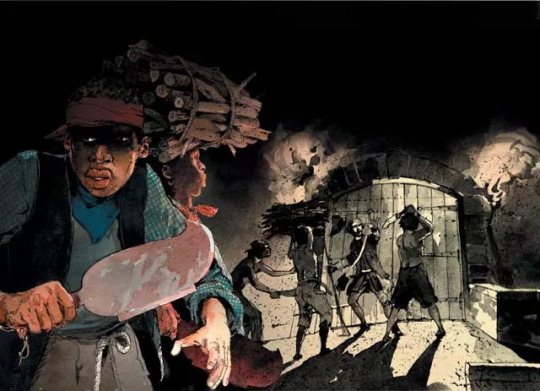
On this day, 23 November 1733 enslaved Akwamu people on the then-Danish colony of St John (now in the US Virgin Islands) launched a rebellion and killed soldiers at the Frederiksværn fort. The rebellion spread from plantation to plantation, killing enslavers and whites. But the Akwamu rebels did not plan to abolish slavery, they aimed to take over the colony, and maintain all of the non-Akwamu Africans in slavery to produce sugar and other crops for them instead of the whites. So some other enslaved people joined the colonists in fighting against the Akwamu. Eventually, more Danish troops arrived, and Britain, concerned about the rebellion potentially spreading to Tortola, sent a warship with more soldiers to John the fight. But the rebels ambushed the warship, wounding four British troops, and sending them fleeing. The Akwamu kept up their fight for months, until eventually, France dispatched soldiers to help the Danes, and eventually they succeeded in suppressing the revolt. Pictured: a painting of the revolt by Richard Schlecht For stories of rebellion like this for every day of the year, check out our 2023 wall calendar: https://shop.workingclasshistory.com/products/wch-wall-calendar https://www.facebook.com/workingclasshistory/photos/a.296224173896073/2142369722614833/?type=3
99 notes
·
View notes
Text

This is a 19th century depiction of Aquasi Boachi and Quamin Poko, sounds of king Quakoe Dua of the Ashanti/Asante people (a subgroup of the Akan people in Western Africa). Quamin Poko was claimed to be heir to the throne. The term Ashanti is really pronounced Asante in it's proper dialect. The "sh" pronunciation and spelling was added in by the British.
The Akan (the Asante/Ashanti's being a sub group) are an ethnic group who currently inhabit Ghana and Ivory Coast. Sub groups of the Akan people also include the Agona, Akuapem, Akwamu, Akyem, Fante, Wassa, Kwahu, Sefwi, Bono and so on. Like the Ashanti, theses Akan subgroups share commonalities based on their cultural practices. A common one is that they trace their origins through their maternal seed line. Hebrewisms of West Africa by Joseph J Williams, published in 1930; "Now, on the one hand, we have no less an authority than Professor Albert T. Clay, of Yale university, that 'some semites used M and others W to represent the same sound! And on the other hand, captain Rattray assures time that in Ashanti the letter M interchanges with W, and quotes Christaller as confirmatory authority. This establishes a surprising similarity between the Ashanti Yame and the Hebrew Tetragrammaton, Yahweh/Yahawah.
15 notes
·
View notes
Text
Discovering the world
Ghana 🇬🇭
Basic facts
Official name: Republic of Ghana
Capital city: Accra
Population: 34.1 million (2023)
Demonym: Ghanaian
Type of government: unitary presidential republic
Head of state and government: Nana Akufo-Addo (President)
Gross domestic product (purchasing power parity): $227.18 million (2023)
Gini coefficient of wealth inequality: 44% (medium) (2024)
Human Development Index: 0.602 (medium) (2022)
Currency: cedi (GHS)
Fun fact: It is home to the largest artificial lake in the world.
Etymology
The country’s name comes from the Ghana Empire, although the latter did not include present-day Ghana. “Ghana” is thought to derive from the title Kaya Maghan, meaning “ruler of gold”.
Geography
Ghana is located in West Africa and borders Burkina Faso to the north, Togo to the east, the Atlantic Ocean to the south, and Côte d’Ivoire to the west.
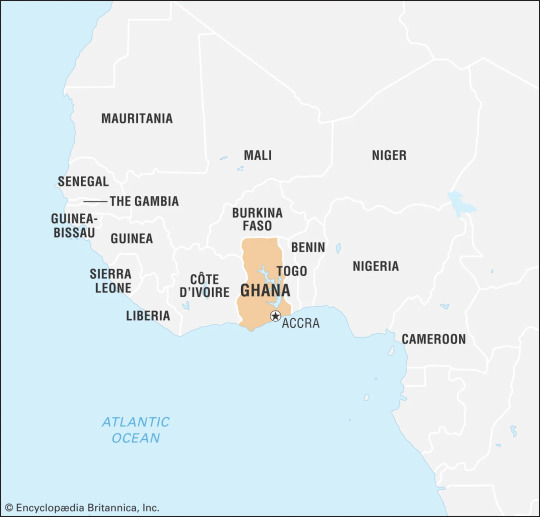
There are two climates: tropical monsoon in the southwest and dry-winter tropical savanna in the rest. Temperatures range from 23 °C (73.4 °F) in winter to 31 °C (87.8 °F) in summer. The average annual temperature is 24.6 °C (76.3 °F).
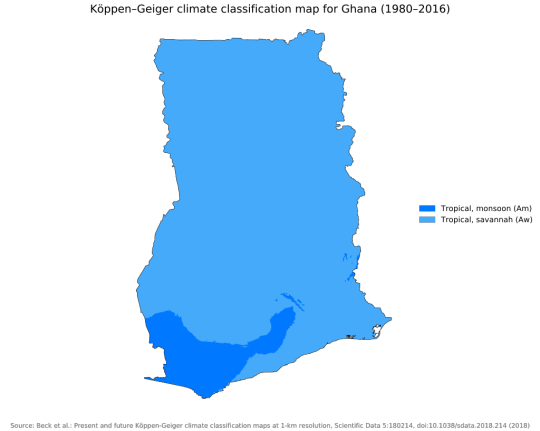
The country is divided into sixteen regions. The largest cities in Ghana are Accra, Kumasi, Tamale, Takoradi, and Sunyani.
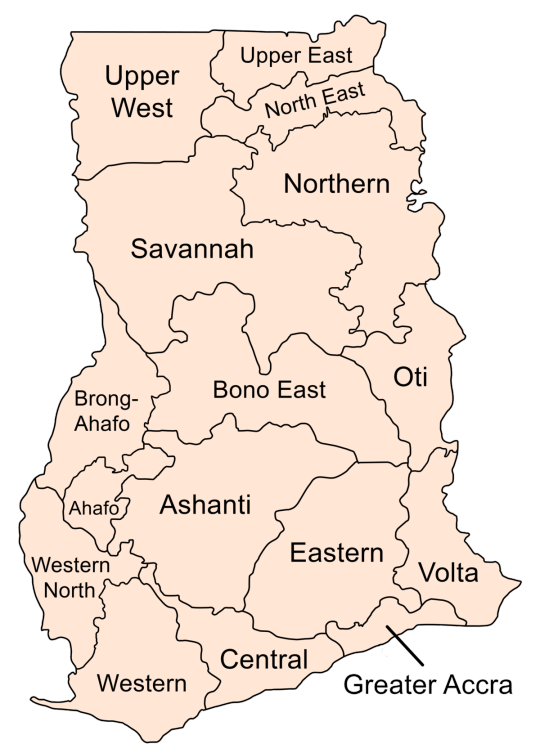
History
11th century-1957: Bono State
1200-present: Kingdom of Dagbon
1482-1642: Portuguese Gold Coast
1500-1701: Denkyira
1600-1734: Kingdom of Akwamu
1612-1872: Dutch Gold Coast
1658-1850: Danish Gold Coast
1650-1663: Swedish Gold Coast
1670-1957: Ashanti Empire
1682-1721: Brandenburger Gold Coast
1806-1807: Ashanti-Fante Confederacy
1821-1957: Colony of the Gold Coast
1823-1900: Anglo-Ashante wars
1884-1914: Togoland Protectorate
1902-1957: Colony of Ashanti; Northern Territories of the Gold Coast
1916-1956: Territory of British Togoland
1957-1960: Ghana
1960-present: Republic of Ghana
1966: coup d’état
1979: June 4th Revolution
Economy
Ghana mainly imports from China, the United States, and the Netherlands and exports to China, Switzerland, and India. Its top exports are cocoa beans, gold, and crude oil.
It has abundant diamond, gas, gold, oil, and silver reserves. Services represent 57.2% of the GDP, followed by industry (24%) and agriculture (18.3%).
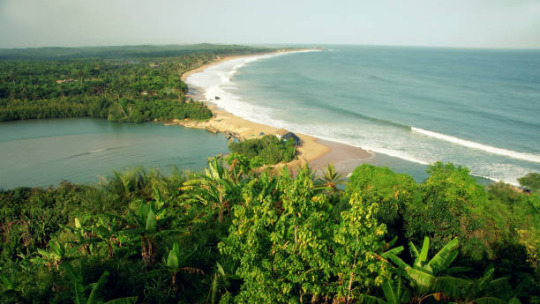
Ghana is a member of the African Union, the Commonwealth, and the Economic Community of West African States.
Demographics
The Akan are the largest ethnic group (45.7%), followed by the Mole-Dagbon (18.5%), Ewe (12.8%), Ga-Adangbe (7.1%), Gurma (6.4%), Guan (3.2%), Gurunsi (2.7%), and Mande (2%). The main religion is Christianity, practiced by 71.3% of the population, 49% of which is Protestant.
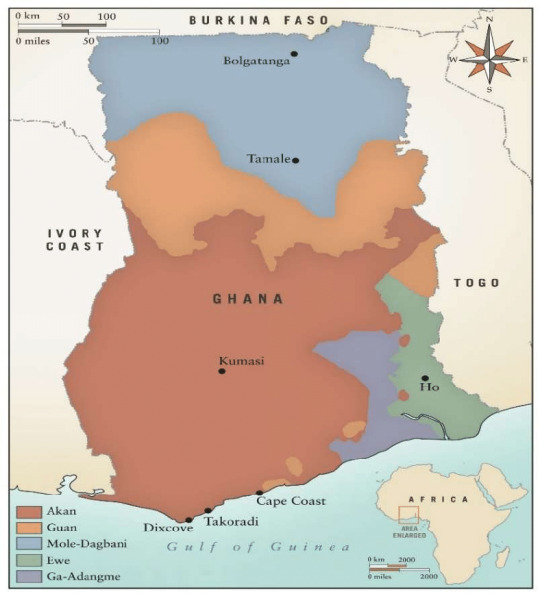
It has a negative net migration rate and a fertility rate of 3.6 children per woman. 58.6% of the population lives in urban areas. Life expectancy is 69.3 years and the median age is 21.4 years. The literacy rate is 79%.
Languages
The official language of the country is English. Akuapem, Asante, Dagaare, Dagbani, Dangme, Ewe, Fante, Ga, Gonja, Kasena, and Nzema are government-sponsored languages.
Culture
Ghanaians highly value politeness and honesty. They address older people using “mother” and “father”.
Men traditionally wear a wide striped tunic (smock), pants (kurugu), and a hat (zipligu). Women wear a longer smock as a dress.

Architecture
Traditional houses in Ghana are rounded, have mud walls, and conical thatched roofs.
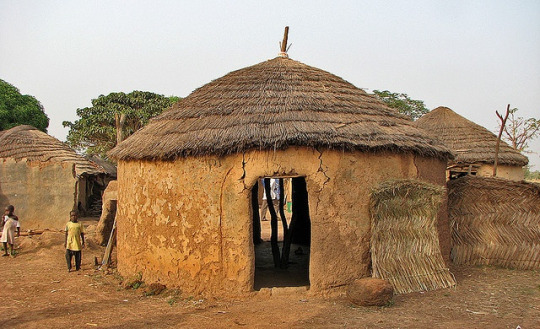
Cuisine
The Ghanaian diet is based on fish, meat, rice, seafood, and vegetables. Typical dishes include kenkey (sourdough dumplings served with fried fish and pepper sauce), koose (a spicy black-eyed pea fritter), mpoto mpoto (a yam stew with fish and onion), tubaani (steamed black-eyed peas pudding wrapped in leaves), and waakye (rice and beans served in a leaf).
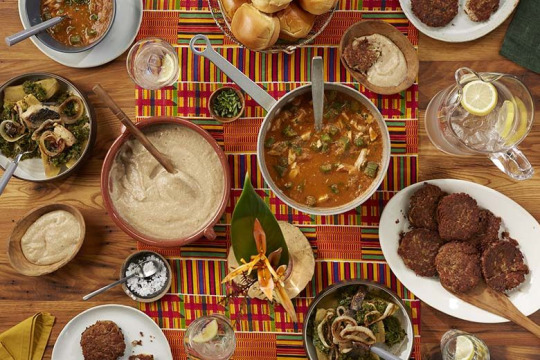
Holidays and festivals
Like other Christian and Muslim countries, Ghana celebrates Good Friday, Easter Monday, Christmas Day, Boxing Day, Eid al-Fitr, and Eid al-Adha. It also commemorates New Year’s Day and Labor Day.
Specific Ghanaian holidays include Constitution Day on January 7, Independence Day on March 6, Founders’ Day on August 4, Kwame Nkrumah Memorial Day on September 21, and Farmers’ Day on the first Friday in December.
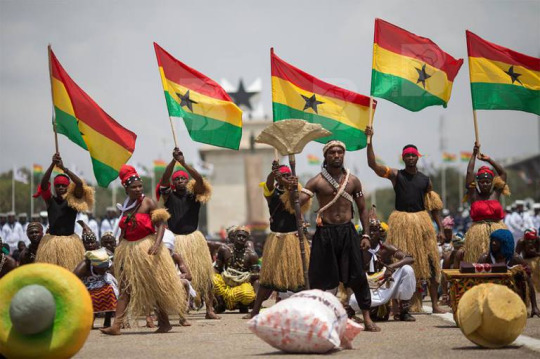
Independence Day
Other celebrations include the Akwasidae Festival, which honors ancestors; the Damba Festival, when traditional dresses are on display, and the Fire Festival, which involves fire processions and drumming.
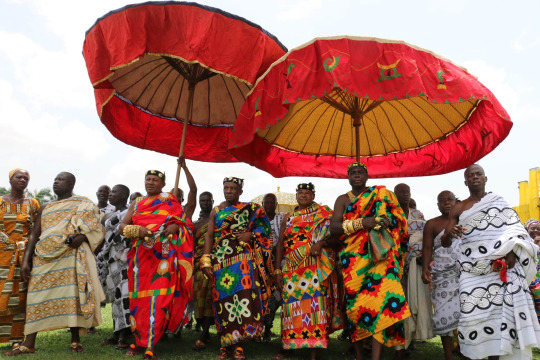
Akwasidae Festival
Landmarks
There are two UNESCO World Heritage Sites: Asante Traditional Buildings and Forts and Castles in the Volta, Greater Accra, Central and Western Regions.
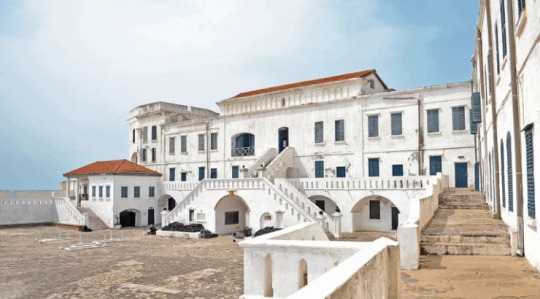
Cape Coast Castle
Other landmarks include the Kakum National Park, the Kwame Nkrumah Mausoleum and Memorial Park, the Larabanga Mosque, the Mole National Park, and the Navrongo Catholic Cathedral.
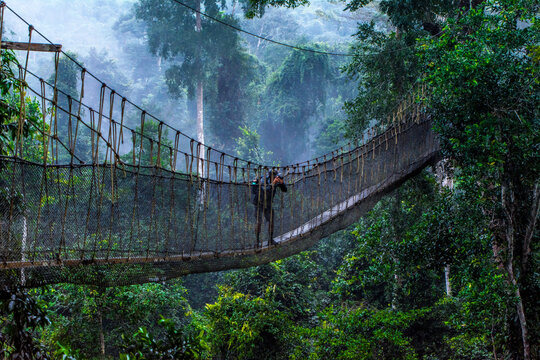
Kakum National Park
Famous people
Ablade Glover - painter
Alice Annum - athlete
Ama Ata Aidoo - writer
Felicia Ansah Abban - photographer
Kwame Akoto-Bamfo - sculptor
Michael Essien - soccer player
Obo Addy - dancer and musician
Sarkodie - rapper
Shirley Frimpong-Manso - movie director
Theodosia Okoh - artist
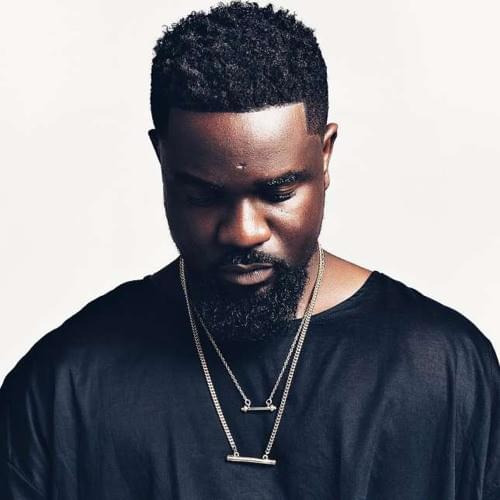
Sarkodie
You can find out more about life in Ghana in this article and this video.
#discoveringtheworld#langblr#akuapem#asante#dagaare#dagbani#dangme#english#ewe#fante#ga#gonja#kasena#nzema
11 notes
·
View notes
Photo

Brief History Of Sunyani The history of Sunyani revolves around a hunter by name Boahen Korkor and another one from Akwamu. Boahen Korkor was a member of the Amakom royal house in Asante. He migrated with his sister, Nyamaa and a large retinue in the 17th century. Boahen Korkor's first settlement was Tanoso near Tano River where a tusk(asonmmen) was installed. The post where the tusk was installed became a shrine for the Tano River God. When the Tano river God became famous and attracted many followers, the Asantehene dispatched his officials to Tanoso where they could also attend the Deity. Out of fear of the domination by the new settlers, Boahen Korkor and his followers moved further and settled at Abesim where a large group of Akwamu (Dormaa) migrants from present day Eastern region settled. Still apprehensive of annexation by the Dormaa people, Boahen Korkor moved further westward and settled on the banks of a stream named Nsankronsua. While at Nsankronsuano, that is at the banks of Nsankrosua, Boahen Korkor met Nana Antepim, another hunter(who had migrated from Denkyira). The two named their place 'Gubre', meaning a stream that refreshes. From Nsankronsuano, Boahen Korkor settled permanently on a parcel of land where elephants were flayed, along with another hunter called Nana Bofotia from Akwamu. The settlement was named "Asonodwae", thus a place for flaying elephants, now corrupted into Sunyani. After the defeat of the Asante by the British in 1900, the federated states of Asante including those in the present day Bono Ahafo region reverted to their autonomous status. The Brong Ahafo area later became an administrative unit called Western Province of Ashanti. On 29th December, 1901, Captain T.E. Fell, acting on behalf of the Chief Commissioner, entered into Land Acquisition Agreement with the Sunyani Stool then occupied by Nana Kwadwo Barnie and acquired the lands on behalf of the Gold Coast Government. The omanhene of Sunyani is Nana Bosoma Asor Nkrawiri ll. ~~#blogger #nanaasanteyekye #Bono #Sunyani #Abakosem #Abakɔsɛm #akan (at Osimpamfm 95.5MHz) https://www.instagram.com/p/CbFTFL2MjX3/?utm_medium=tumblr
0 notes
Text
Akufo-Addo is Rawlings’ nephew – Akwamu State Historian
Akufo-Addo is Rawlings’ nephew – Akwamu State Historian
[vc_row css_animation=”” row_type=”row” use_row_as_full_screen_section=”no” type=”full_width” angled_section=”no” text_align=”left” background_image_as_pattern=”without_pattern”][vc_column][vc_column_text]The Akwamu State is one of the oldest Akan States, known for its well-organised army during the pre-colonial days. In the 16th century, they conquered many Ghanaian and Togolese tribes and…

View On WordPress
0 notes